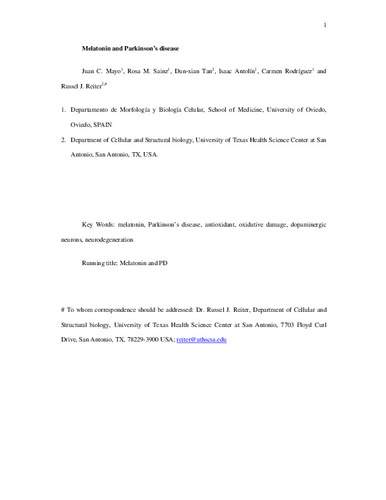Melatonin and parkinson’s disease
Palabra(s) clave:
Melatonin, antioxidant, oxidative stress, Parkinson's disease
Fecha de publicación:
Versión del editor:
Citación:
Descripción física:
Resumen:
Parkinson’s disease (PD) is the second most common neurodegenerative disorder after Alzheimer’s disease. It is characterized by a progressive loss of dopamine in the substantia nigra and striatum. However, over 70% of dopaminergic neuronal death occurs before the first symptoms appear, which makes either early diagnosis or effective treatments extremely difficult. Only symptomatic therapies have been used, including levodopa (L-dopa), to restore dopamine content; however, the use of L-dopa leads to some long-term pro-oxidant damage. In addition to a few specific mutations, oxidative stress and generation of free radicals from both mitochondrial impairment and dopamine metabolism are considered to play critical roles in PD etiology. Thus, the use of antioxidants as an important co-treatment with traditional therapies for PD has been suggested. Melatonin, or N-acetyl-5-methoxy-tryptamine, an indole mainly produced in the pineal gland, has been shown to have potent endogenous antioxidant actions. Because neurodegenerative disorders are mainly caused by oxidative damage, melatonin has been tested successfully in both in vivo and in vitro models of PD. The present review provides an up-to-date account of the findings and mechanisms involved in neuroprotection of melatonin in PD.
Parkinson’s disease (PD) is the second most common neurodegenerative disorder after Alzheimer’s disease. It is characterized by a progressive loss of dopamine in the substantia nigra and striatum. However, over 70% of dopaminergic neuronal death occurs before the first symptoms appear, which makes either early diagnosis or effective treatments extremely difficult. Only symptomatic therapies have been used, including levodopa (L-dopa), to restore dopamine content; however, the use of L-dopa leads to some long-term pro-oxidant damage. In addition to a few specific mutations, oxidative stress and generation of free radicals from both mitochondrial impairment and dopamine metabolism are considered to play critical roles in PD etiology. Thus, the use of antioxidants as an important co-treatment with traditional therapies for PD has been suggested. Melatonin, or N-acetyl-5-methoxy-tryptamine, an indole mainly produced in the pineal gland, has been shown to have potent endogenous antioxidant actions. Because neurodegenerative disorders are mainly caused by oxidative damage, melatonin has been tested successfully in both in vivo and in vitro models of PD. The present review provides an up-to-date account of the findings and mechanisms involved in neuroprotection of melatonin in PD.
ISSN:
Colecciones
- Artículos [36339]
- Morfología y Biología Celular [166]
Ficheros en el ítem





